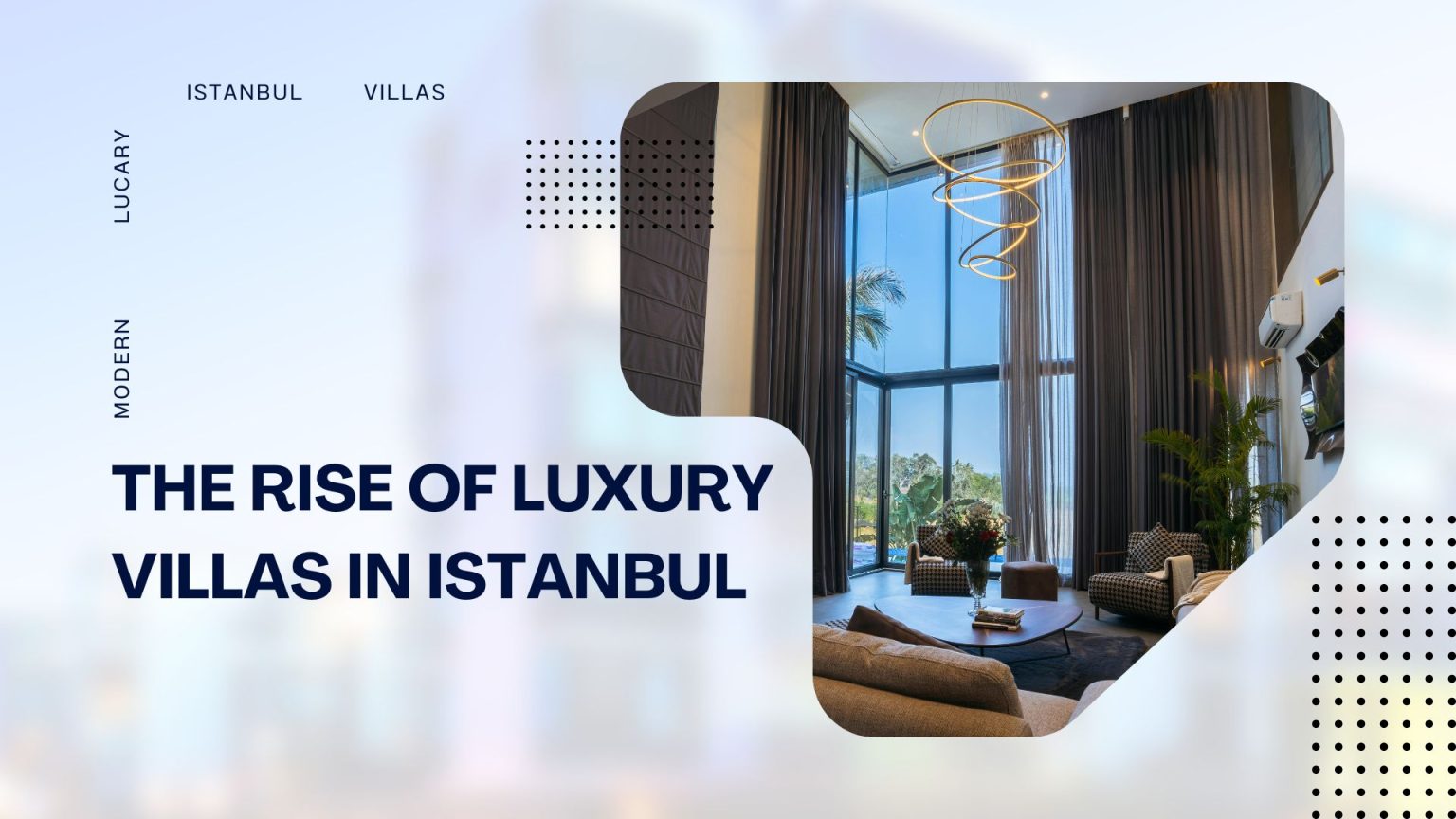Introduction
In recent years, urban landscapes have undergone significant transformations, reflecting broader socio-economic trends. These changes are particularly evident in Istanbul, where an increasing appetite for exclusivity and prestige has catalyzed the luxury real estate market. Among the most noteworthy developments is the emergence of luxury villas, which symbolize both a lifestyle aspiration and an investment opportunity. This phenomenon is not merely a response to demand; it encompasses various factors, including tourism growth, foreign investment, and changing demographics. Understanding this dynamic market necessitates a comprehensive analysis of its underlying drivers and implications for stakeholders. Thus, this dissertation seeks to explore the rise of luxury villas in Istanbul, offering insights into the current market landscape while examining future trajectories.
1. Definition of luxury villas
In recent years, the concept of luxury villas has evolved significantly within urban contexts, particularly in rapidly developing cities like Istanbul. These expansive residences often embody a blend of opulence, privacy, and exclusivity. Luxury villas typically feature high-end architectural designs along with lavish amenities that cater to affluent lifestyles, such as private pools, landscaped gardens, and advanced security systems. As (Afshari et al.) emphasizes, these properties often exist within gated communities, enhancing residents sense of security while separating them from urban chaos. This spatial segregation not only magnifies the allure of luxury villas but also reflects broader socio-economic patterns shaping the metropolitan landscape. Therefore, the definition of luxury villas must encompass both their physical attributes and the associated lifestyle they promote, reinforcing their appeal in an increasingly competitive real estate market. As such, luxury villas signify more than mere residences; they represent a distinct social status and a coveted way of life.
2. Overview of Istanbul’s real estate market
The evolution of Istanbuls real estate market reflects broader socio-economic shifts in Turkey. Since the 1980s, the city has experienced significant urban sprawl, particularly in fringe areas, characterized by the emergence of high-rise buildings and gated communities. This trend has been fueled by a growing middle class with increased purchasing power, driving demand for luxury housing options. Recent marketing strategies have capitalized on this demographic shift, promoting lifestyle aspirations through targeted advertising. As a result, luxury villas and single-family housing estates are increasingly prevalent, showcasing a blend of modern architecture and desirable amenities within a rapidly changing urban landscape, which symbolizes the transformative influence of globalization on local real estate dynamics (cite3; cite4). These developments are essential in understanding the factors contributing to the rise of luxury villas in Istanbul’s competitive market.
3. Importance of luxury villas in urban development
The urban landscape of Istanbul has undergone significant transformations, particularly in the wake of globalization and economic restructuring. These developments have reshaped housing dynamics, highlighting the importance of luxury villas within this context. Such properties not only cater to an affluent demographic but also stimulate local economies through increased property values and investment potential. As noted, residents are attracted to areas offering modern amenities and scenic views, impacting housing prices and neighborhood desirability (Ozus et al.). Furthermore, the emergence of luxury villas reflects broader socio-cultural shifts, aligning with global lifestyle trends and contributing to urban sophistication (Tuğlu Karslı et al.). Consequently, integrating luxury villas into the urban development framework is crucial for sustainable growth that addresses both economic demands and cultural aspirations in Istanbul.
4. Purpose of the market analysis
The rapid transformation of Istanbuls urban landscape necessitates a comprehensive market analysis. This analytical framework aims to elucidate the emerging trends in luxury villas, emphasizing socio-economic factors that influence buyer behavior. Notably, externalization and globalization have reshaped Istanbul, increasing the significance of the luxury housing sector reflected in changing pricing dynamics and consumer preferences (Tuğlu Karslı et al.). Moreover, understanding market forces helps stakeholders identify opportunities and challenges, particularly in the context of demographic shifts and infrastructure developments (Ozus et al.). Consequently, this analysis not only delineates the characteristics of luxury villas but also informs investment strategies and policy-making, ensuring sustainable urban growth while accommodating diverse socio-economic needs. Ultimately, the purpose of this market analysis extends beyond mere economic data; it cultivates a nuanced understanding of a rapidly evolving real estate market shaped by cultural and environmental factors aligned with global trends.
5. Methodology and data sources
In exploring the rise of luxury villas in Istanbul, a multifaceted methodology was employed. Qualitative research served as the backbone, enabling an in-depth analysis of architectural design elements and their role in social differentiation. Two specific gated communities designed by acclaimed Turkish architect Mehpare Evrenol were examined. Data was collected through architectural surveys, interviews, and participant observations, allowing for a comprehensive understanding of residents experiences. Interviews with industry experts and potential investors further enriched the analysis, providing insights into market trends and preferences. The integration of these diverse data sources ensures a robust framework for understanding the dynamics at play within this burgeoning real estate market in Istanbul. By employing this diverse methodological approach, the study elucidates the intricate relationships between architectural design, social dynamics, and market forces that influence the luxury villa sector in Turkeys capital.
Historical Context of Luxury Villas in Istanbul
The evolution of luxury villas in Istanbul is steeped in the city’s intricate historical tapestry. Once the opulent retreats of Ottoman elites, these villas reflect a blend of architectural influences alongside cultural transformations. This phenomenon was particularly pronounced during the late 19th century, as the empire embraced Western styles while retaining its unique identity. With the advent of economic liberalization in recent decades, the luxury villa market has experienced a resurgence. Emerging elites, shaped by evolving social networks delineated by factors such as religion and origin, actively seek residences that signify status and modernity (Ali Ergur et al.). Consequently, these villas not only serve as homes but also as embodiments of wealth and cultural identity, marking a distinct trend within the contemporary real estate landscape in Istanbul. The historical context is vital to understanding the current dynamics and preferences shaping luxury living in the city.
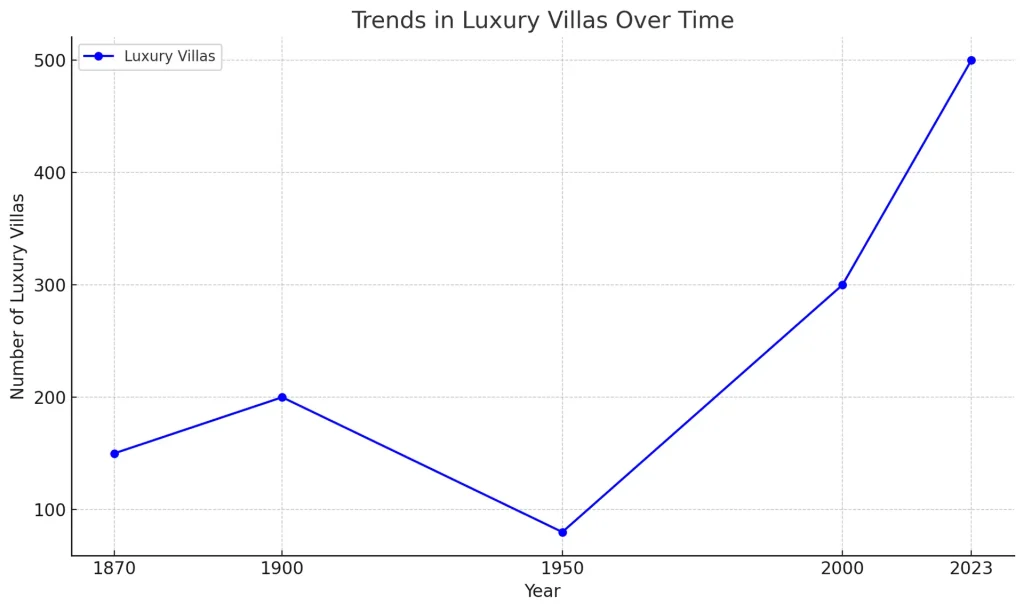
The chart illustrates the trend in the number of luxury villas from the year 1870 to 2023. It highlights fluctuations over time, including a notable decrease in the mid-20th century, followed by a significant increase in the 21st century, peaking at 500 villas in 2023.
1. Evolution of luxury living in Istanbul
The transformation of Istanbul’s luxury living landscape reflects broader socio-economic shifts. Over recent decades, urban development and rising wealth among elites have catalyzed demand for extravagant residences. Consequently, luxury villas have emerged as a symbol of prestige. These properties often fuse traditional aesthetics with modern amenities, appealing to a diverse affluent clientele. Moreover, the interplay of social networks, especially among the business elite, has significant implications for the luxury market. As identified in the discourse analysis of elite interactions, institutional variables shape preferences and demand dynamics within the luxury sector (Ali Ergur et al.). Such insights illuminate the evolving nature of luxury living, revealing how identity and economic factors jointly redefine residential aspirations in Istanbul. Understanding this evolution is crucial for professionals navigating the market, as it underscores the complexities inherent in catering to a discerning, affluent populace.
2. Key historical events influencing real estate
The evolution of Istanbuls real estate market has been profoundly shaped by historical milestones. The citys strategic geographical location has drawn international interest, particularly post-Ottoman Empire. The opening of the Trans European Motorway transformed accessibility, enhancing property values across surrounding areas. Furthermore, the rise of globalization in the early 21st century fueled luxury real estate demand, evident in the increasing focus on high-end developments such as villas. Changes in design trends have also contributed, as luxurious amenities and modern aesthetics became sought after (Bekar et al.). Conversely, initiatives that dictated urban planning, alongside inequities highlighted in global events, have further dictated the luxury market’s dynamics (Tsumura et al.). Understanding these key events elucidates the architectural and economic fabric of Istanbuls real estate sector.
3. Architectural styles of luxury villas
The emergence of luxury villas in Istanbul reflects a confluence of diverse architectural influences. Contemporary housing designs often integrate elements from modernism, minimalism, and traditional Ottoman aesthetics, resulting in a unique synthesis that caters to affluent buyers. Gated communities, often characterized by villas that emphasize exclusivity and security, have proliferated in response to globalization’s impact on urban lifestyles, as seen in studies highlighting transformations post-1980 (Tuğlu Karslı et al.). These structures are marketed with aspirational imagery that appeals to a new middle class, illustrating lifestyle desires rather than mere function (Erten et al.). Consequently, the architectural styles of luxury villas not only accommodate the preferences of their residents but also act as indicators of Istanbul’s socio-cultural evolution within a globalized framework. Such design choices articulate a narrative of both prestige and cultural resonance in the modern urban landscape.
4. Notable luxury villa developments
The intersection of consumer culture and urban development in Istanbul has paved the way for notable luxury villa projects. These developments cater to an emerging middle class with substantial purchasing power, reflecting aspirational lifestyles. As highlighted in recent studies, marketing strategies shape the spatial characteristics of these gated communities, emphasizing an ideal lifestyle through various media (Erten et al.). This trend is further underpinned by growing consumer demand for premium products and services, indicating a shift towards more sophisticated living environments (Bozkaya et al.). The proliferation of luxury villas within the city serves not only as a response to market dynamics but also as a manifestation of changing societal values and expectations. Such projects not only redefine residential architecture but also significantly impact the urban landscape, infusing it with both exclusivity and modernity. These factors collectively support the rise of luxury villas as a notable segment in Istanbuls real estate market.
| Development Name | Location | Price Range (USD) | Completion Year | Number of Villas |
| Aqua Vista | Bosphorus, Istanbul | $1.5M – $3.2M | 2022 | 50 |
| Sapphire Shores | Çamlica, Istanbul | $2M – $4M | 2024 | 30 |
| Golden Grove | Kucukcekmece, Istanbul | $1M – $2.5M | 2023 | 40 |
| Villaway Hills | Nişantaşı, Istanbul | $3M – $5M | 2021 | 25 |
| Skyline Villas | Beylikdüzü, Istanbul | $800K – $1.5M | 2023 | 60 |
Notable Luxury Villa Developments in Istanbul
5. Comparison with other global markets
The evolution of Istanbul’s luxury villa market can be better understood when juxtaposed with other global real estate arenas. For instance, cities like Dubai and Miami have witnessed explosive growth in high-end residential developments, driven by foreign investment and tourism. This contrasts with Istanbul, where local economic dynamics, influenced by the unique geographical context and sociopolitical climate, play a prominent role in shaping market trends. According to (Ozus et al.), Istanbul’s strategic location and infrastructural advancements have bolstered its appeal. Yet, the disparity in income levels elucidates a divide in the luxury housing market when compared to more economically homogenous locales. Furthermore, social networks among elites, as noted in (Ali Ergur et al.), have facilitated distinct patterns of investment in Istanbul, reflecting broader shifts in wealth distribution and preferences that differentiate it from other luxury markets worldwide.
| City | Average Price (USD) | Market Growth Rate (%) | Luxury Villa Sales (Units) | Year |
| Istanbul | 1 | 12.5 | 850 | 2023 |
| Miami | 2 | 10.3 | 1 | 2023 |
| Dubai | 3 | 15.1 | 1 | 2023 |
| Barcelona | 1.5 | 8.7 | 600 | 2023 |
| Los Angeles | 4.5 | 9.2 | 1 | 2023 |
| London | 5 | 7.5 | 450 | 2023 |
Luxury Villas Market Comparison
Current Market Trends
The transformation of the residential sector in Istanbul reflects broader global economic trends. The influence of globalization has precipitated a shift in housing preferences, driving affluent buyers towards luxury villas. As reported, this housing evolution stems from significant social and spatial changes that emerged post-1980, predominantly due to urban transformation and gentrification (Tuğlu Karslı et al.). Consequently, luxury villas have become symbols of status and lifestyle, appealing to both local and foreign investors. Current market dynamics indicate a growing demand for exclusive living spaces, fueled by increased disposable income and a desire for quality amenities in urban settings. Additionally, this market demonstrates resilience amid fluctuating economic conditions, suggesting that investment in luxury villas remains a viable option (Ana-Maria Nica et al.). Thus, the rise of luxury villas in Istanbul is not merely a local trend; it mirrors a broader demand for premium residential experiences globally.
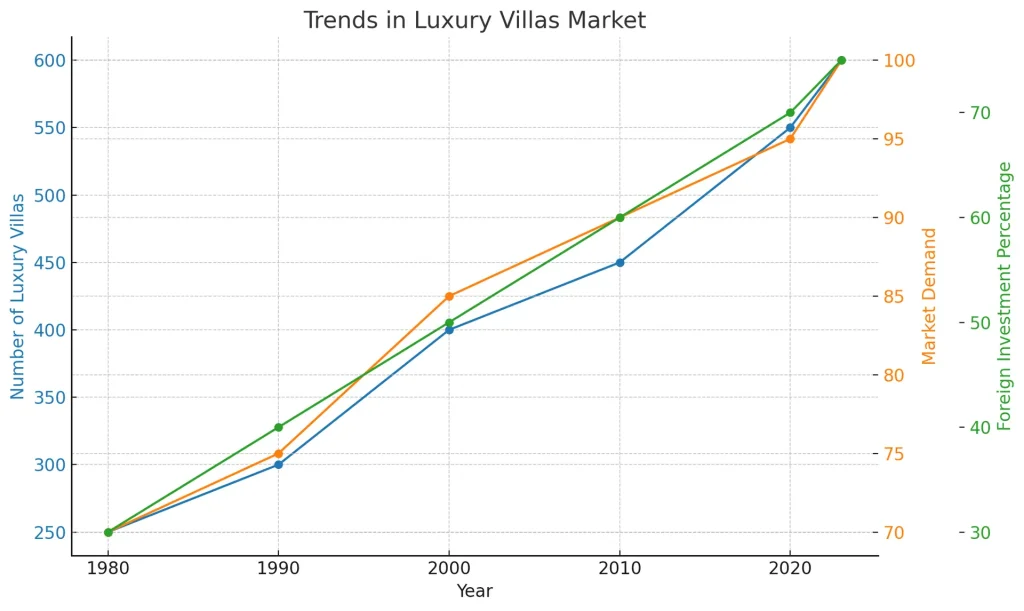
The chart illustrates the trends in the luxury villas market over several decades from 1980 to 2023. The number of luxury villas significantly increased over the years, alongside a rise in market demand and foreign investment percentage. Each metric follows a positive trajectory, indicating growth in the luxury real estate market and increasing appeal to international investors.
1. Demand for luxury villas in Istanbul
The transformation of Istanbuls urban landscape has significantly intensified the demand for luxury villas. This demand correlates with the citys rapid growth fueled by both national migrations and the influx of international residents seeking upscale living conditions. Developments along the Bosphorus and Marmara Sea shores have further enhanced the appeal of these properties, driving prices upward as the quality of housing improves ((Ozus et al.)). Moreover, marketing strategies that highlight luxury lifestyles have effectively targeted a newly affluent middle class. This population actively seeks properties that promise exclusivity and comfort, aligning with their aspirations ((Erten et al.)). Thus, the intersection of urban development, economic factors, and strategic marketing has created a unique environment fostering the rise of luxury villas in Istanbul, making them a prominent facet of the citys real estate landscape.
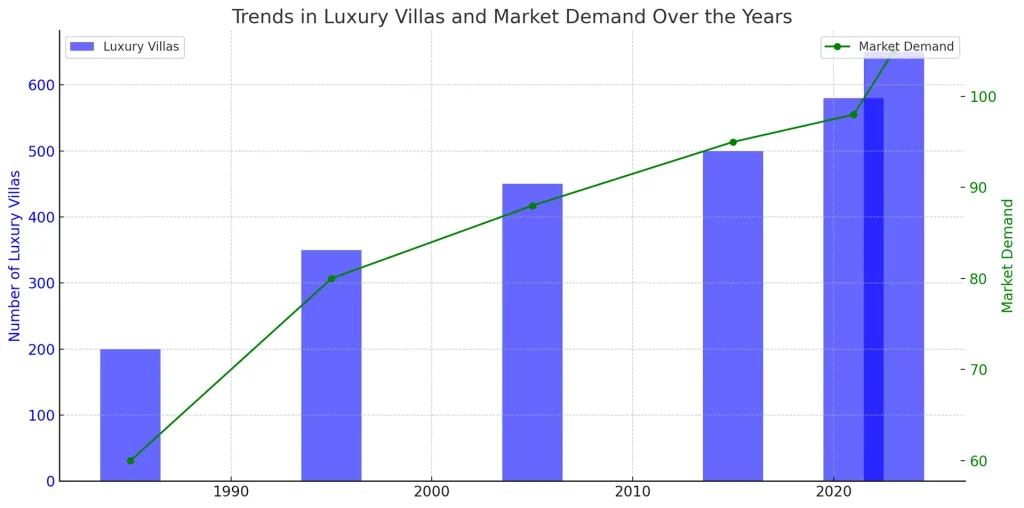
The chart illustrates the trends in the number of luxury villas and market demand over the years from 1985 to 2023. The blue bars represent the increase in the number of luxury villas, while the green line indicates the market demand. It is evident that both metrics show a significant upward trend over the specified years.
2. Demographics of luxury villa buyers
In the context of Istanbuls booming luxury villa market, it is crucial to understand the demographics of potential buyers. Primarily, affluent individuals hail from both domestic and international backgrounds, with many seeking properties that signify social status and exclusivity. Emerging trends indicate that buyers are not only wealthy Turks but also expatriates and foreign investors. This diversification stems from Istanbuls appeal as a cultural and commercial hub, offering distinct lifestyle benefits. Furthermore, (Serin et al.) underscores that housing enclaves, particularly branded projects, cater to this demographic by providing enhanced urban services and amenities. The combination of premium offerings and strategic location attracts a varied clientele, each driven by unique motivations but united in their pursuit of luxury. Consequently, the demographic profile of luxury villa buyers has become a significant factor influencing the ongoing expansion of this market segment in Istanbul.
| Age Group | Percentage | Income Level | Nationality |
| 25-34 | 15 | High | Turkey |
| 35-44 | 30 | Very High | Russia |
| 45-54 | 25 | High | United Arab Emirates |
| 55-64 | 20 | High | Germany |
| 65 and above | 10 | High | United Kingdom |
Demographics of Luxury Villa Buyers in Istanbul
3. Pricing trends and property values
The dynamics of the Istanbul real estate market reveal significant trends in pricing and property values, especially concerning luxury villas. Recent analyses indicate that growing demand from both domestic and international buyers has intensified competition, driving up prices in this sector. According to a study, factors such as Turkeys stable economic growth, coupled with favorable foreign investment policies, have made the luxury segment particularly appealing ((Ciller et al.)). Moreover, the unique geographical and cultural assets of Istanbul enhance the desirability of such properties. This increased interest correlates with rising property values, further influenced by the limited availability of prime locations. As luxury villas continue to proliferate, understanding these trends is crucial for stakeholders aiming to navigate the complexities of the market effectively. Conducting thorough feasibility studies and market analysis will be essential for informed investment decisions in this evolving landscape ((Hacısalihoğlu et al.)).
| Year | AveragePricePerSquareMeter | AnnualPriceIncreasePercentage | NumberOfSales |
| 2021 | 4500 | 10 | 1200 |
| 2022 | 4950 | 10 | 1300 |
| 2023 | 5500 | 11 | 1450 |
Pricing Trends and Property Values of Luxury Villas in Istanbul
4. Popular neighborhoods for luxury villas
The shifting landscape of luxury residential development in Istanbul has led to the emergence of several neighborhoods that epitomize opulence. Areas such as Bebek and Etiler have gained prominence due to their proximity to the Bosphorus and sophisticated amenities. These neighborhoods attract affluent buyers seeking both security and exclusivity, characteristics often marked by gated communities (Al Shawish et al.). Furthermore, the transformations driven by urban gentrification have influenced real estate dynamics, creating desirable living conditions and thus enhancing property values significantly (Uçak et al.). As luxury villas proliferate, the demand for such prestigious locales reflects broader socioeconomic trends and urban planning processes. Ultimately, the interplay of location and lifestyle positions these neighborhoods as prime candidates in the luxury villa market, driving an upward trajectory in investment and interest.
5. Impact of tourism on the luxury market
As the landscape of tourism evolves, a distinct shift in consumer preferences shapes the luxury market. The proliferation of social media has changed how potential guests engage with luxury offerings. People increasingly rely on online reviews to gauge service quality and overall experience (Ban et al.). This trend has significant implications for the luxury villa market in Istanbul, where maintaining a stellar online presence and reputation is crucial for attracting discerning clients. Furthermore, the market faces competition not only from traditional hotels but also from alternative luxury accommodations globally, pushing stakeholders to innovate and diversify their offerings (Maria TOURI et al.). Luxury villas must now embody unique attributes—such as exclusivity, high-end amenities, and personalized services—to appeal to affluent travelers. Therefore, understanding the interconnected dynamics of tourism and luxury consumption is essential for market sustainability and growth in this burgeoning sector.
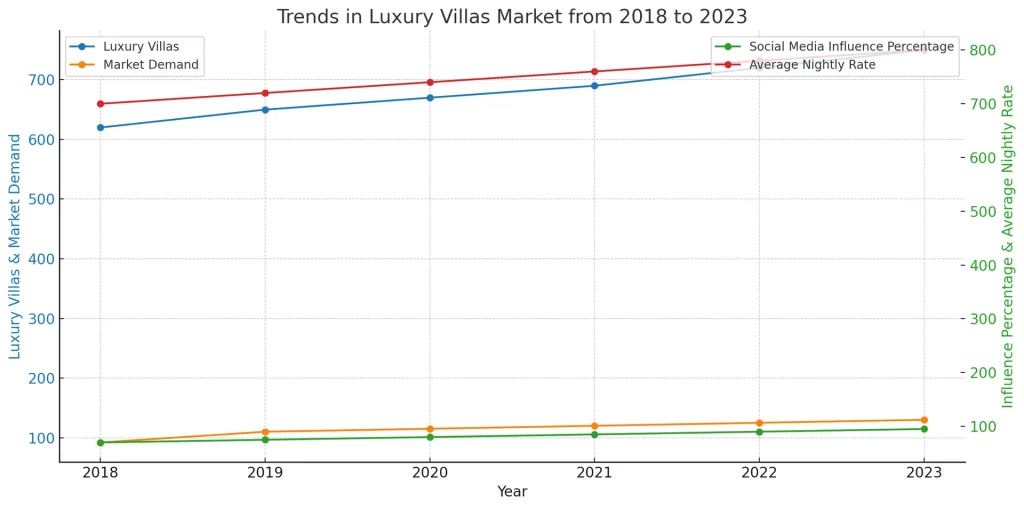
The chart displays trends in the luxury villas market from 2018 to 2023. It highlights the growth of luxury villas, market demand, social media influence percentage, and average nightly rates over the years. Each metric shows an overall positive trend, indicating a healthy market growth and impact from social media influence on consumer demand.
Economic Factors Influencing the Market
The economic landscape in Istanbul significantly shapes the demand for luxury villas. Rising disposable incomes among affluent individuals drive a greater appetite for premium living options. Moreover, the increasing prevalence of international investment enhances the citys appeal, compelling overseas buyers to acquire high-end properties. Additionally, economic stability boosts the confidence of local buyers, fostering a robust real estate market. As highlighted in recent studies, consumer expectations evolve with improved logistics and access to premium products, underscoring the importance of tailored offerings in luxury real estate ((Bozkaya et al.)). Furthermore, the influence of social media on customer perceptions impacts purchasing decisions, with online reviews shaping aspirations toward luxury living ((Ban et al.)). These interconnected economic factors collectively fuel the expansion of the luxury villa market in Istanbul, reflecting broader trends in consumer behavior and preferences.
1. Role of foreign investment in real estate
The dynamics of the luxury real estate market in Istanbul have been notably influenced by foreign investment, which has emerged as a driving force behind recent developments. This influx has reshaped urban landscapes and diversified the offerings within the residential sector. As globalization gained momentum in the late 20th century, housing production adapted to meet the demands of a wealthier, more globalized clientele seeking lifestyle properties. Consequently, contemporary marketing strategies have played a pivotal role in portraying these luxury villas as symbols of an aspirational lifestyle, catering to affluent buyers both locally and abroad. Investments from foreign entities have, therefore, not only contributed to urban transformation but have also engendered a new class of real estate, reflecting the socio-economic shifts in Istanbul’s housing market and enhancing its appeal on the global stage (Tuğlu Karslı et al.)(Erten et al.).
2. Economic indicators affecting luxury villa sales
The interplay of economic indicators significantly shapes the landscape of luxury villa sales in Istanbul. Notably, rising disposable incomes among affluent populations enhance purchasing power and demand for high-end properties. Economic stability, characterized by low inflation and interest rates, further encourages investment in luxury real estate. Additionally, the influx of foreign investors seeking both residency and profit mitigates risks associated with market volatility. Over the past decade, the commodification of urban spaces, propelled by neoliberal policies, has created exclusive enclaves that attract wealthy buyers, reflecting broader socio-economic shifts in the region (Tuğlu Karslı et al.)(Serin et al.). These indicators collectively contribute to a burgeoning market, underscoring the intricate relationship between economic health and luxury villa transactions. As the market evolves, understanding these dynamics becomes essential for stakeholders aiming to navigate this competitive arena effectively.
| Year | GDP Growth Rate (%) | Inflation Rate (%) | Unemployment Rate (%) | Average Selling Price of Luxury Villas (USD) | Population Growth Rate (%) | Foreign Investment in Real Estate (Million USD) | Interest Rate (%) |
| 2023 | 5.5 | 15.2 | 9.5 | 1 | 1.2 | 2 | 14 |
| 2022 | 5 | 19.1 | 11 | 920 | 1.3 | 1 | 13 |
| 2021 | 11 | 14.6 | 12.5 | 800 | 1.4 | 800 | 10.5 |
Economic Indicators Affecting Luxury Villa Sales in Istanbul
3. Government policies and regulations
The transformation of Istanbuls luxury villa market is intrinsically linked to governmental policies and regulations. These frameworks have directly influenced market dynamics, driving both demand and supply. Recent urban development strategies have prioritized the construction of luxury residences, promoting economic growth through foreign investment. Notably, in response to globalization and economic liberalization, the governments facilitation of property ownership for non-residents has furthered this trend, enhancing the appeal of luxury villas ((Ali Ergur et al.)). Additionally, infrastructural developments, such as improved transportation, have made previously undervalued areas attractive, leading to increased property values and gentrification ((Ozus et al.)). These initiatives underscore the role of regulatory frameworks in shaping a burgeoning market, ultimately reflecting broader societal shifts in wealth and housing quality. As property regulations evolve, understanding their impact on real estate trends becomes essential for comprehending the rise of luxury villas in Istanbul’s complex landscape.
4. Financing options for buyers
As the demand for luxury villas in Istanbul continues to surge, potential buyers must navigate various financing options to secure their investments. Traditional mortgage solutions remain prevalent, often coupled with competitive interest rates tailored for high-net-worth individuals. Additionally, many developers offer flexible payment plans, easing the affordability barrier for prospective buyers. Alternative financing avenues, such as equity partnerships, are emerging as attractive choices, enabling investors to share risks and profits. These varied financing mechanisms cater to diverse financial capacities, enhancing accessibility to a burgeoning market characterized by escalating property values and affluent clientele.
5. Impact of currency fluctuations
The economic landscape of Istanbuls luxury villa market is significantly influenced by currency fluctuations. Such variability can alter pricing structures and demand dynamics among both local and foreign investors. A stronger Turkish Lira may deter international buyers due to higher costs, while a weaker Lira can enhance the allure of real estate investments for foreign investors, thus stimulating market activity. Additionally, the investment decisions by local elites are shaped by these fluctuations, as they navigate the complexities of cost, risk, and projected returns in a volatile currency environment (Ali Ergur et al.). Understanding these trends is essential for stakeholders, as effective strategies must be developed to mitigate potential risks associated with currency changes. Thus, monitoring exchange rates and adapting investment approaches in response to macroeconomic indicators become crucial for sustaining growth in this luxury sector (Friberg et al.).
Social and Cultural Influences
The transformation of Istanbuls urban landscape is deeply intertwined with social and cultural shifts. As elite business communities reshape their networks, the demand for luxury villas reflects both aspirational lifestyles and emerging social class identities. Notably, the interplay of religious and secular values informs property investments, influencing architectural designs and community interactions ((Ali Ergur et al.)). Additionally, the preservation of historical identity amidst rapid urbanization prioritizes sustainable practices in villa development ((Çahantimur et al.)). This blend of tradition and modernity is crucial, as it impacts both the market’s dynamics and the cultural narrative surrounding luxury living in Istanbul. Understanding these dimensions is essential for a comprehensive market analysis.
1. Lifestyle changes driving luxury villa demand
The transformation of Istanbul’s urban landscape reflects broader societal shifts. Increasing affluence among residents has fueled a demand for luxury villas, which symbolize status and enhanced living standards. The emergence of a new middle class with substantial purchasing power has catalyzed this trend, appealing to desires for spacious homes in attractive surroundings. Advertising strategies further amplify this demand, promoting an ideal lifestyle through targeted campaigns that associate luxury living with opulence and well-being (Erten et al.). Additionally, the citys developments, including improved infrastructure and accessible amenities, have made previously overlooked areas desirable (Ozus et al.). Collectively, these factors have reshaped not only the preferences of potential buyers but also the market dynamics governing luxury real estate in Istanbul.
2. Influence of social media on buyer preferences
The contemporary landscape of real estate is increasingly shaped by social media platforms, which serve as pivotal tools in influencing buyer preferences, particularly in the luxury villa market in Istanbul. Potential buyers frequently turn to platforms like Instagram and Facebook for visual inspiration and lifestyle validation, which significantly impacts their purchasing decisions. These platforms facilitate real-time interaction between buyers and sellers, fostering brand loyalty and showcasing luxury properties through curated content. Consequently, real estate agents and developers leverage social media marketing strategies to reach targeted demographics effectively. With the rise of influencer endorsements and community-driven discussions, homebuyers are more inclined to consider properties that align with aspirational living, demonstrating a clear correlation between social media engagement and the evolving buyer preferences in luxury real estate markets (Alhubashi et al.)(Alhubashi et al.). Thus, understanding this dynamic is crucial for stakeholders aiming to navigate and optimize their market presence.
3. Cultural significance of luxury living
As urban landscapes evolve, luxury living increasingly symbolizes status and cultural identity. In Istanbul, the emergence of luxury villas reflects a desire to reconnect with the city’s historical grandeur while catering to modern aspirations. Gated communities represent a distinct response to social polarization, manifesting a complex interplay between exclusivity and access (Afshari et al.). These developments, often adorned with architectural motifs reminiscent of Istanbuls rich past, evoke a sense of heritage and belonging among residents, enhancing their cultural capital (Göksel et al.). Moreover, these luxurious enclaves provide a curated environment that promotes social cohesion within insulated spaces. Consequently, luxury living in Istanbul serves not merely as a marker of wealth but also as a cultural phenomenon that shapes urban dynamics and individual identities amid a diverse society. This cultural significance underscores the importance of understanding the implications of such developments on social fabric and urban development.
4. Community and exclusivity in luxury developments
The appeal of luxury villas in Istanbul extends beyond mere opulence; it encapsulates the allure of community and exclusivity. In recent years, gated communities have emerged as a defining feature of this luxury segment, catering to affluent buyers seeking a sense of belonging alongside their high-end lifestyles. These developments often tout lifestyle characteristics that resonate with an emerging middle class, constructed through strategic marketing narratives that promise an ideal lifestyle (cite55). This cultivated sense of community not only enhances the residential experience but also reinforces social stratification, where exclusivity becomes a cornerstone of identity. Furthermore, the synergy between urban branding and luxury real estate fosters a complex relationship between location, community, and individual aspirations, thereby shaping the perceptions surrounding these luxury developments (cite56). Consequently, the luxury villa market in Istanbul significantly reflects broader societal dynamics, intertwining community engagement with exclusivity in its allure.
5. Sustainability trends in luxury villa construction
In recent years, the luxury villa market in Istanbul has witnessed a significant shift towards sustainability, reflecting broader global trends in construction practices. Developers are increasingly incorporating eco-friendly materials and technologies into their projects, thereby aligning with environmental goals. For instance, the use of renewable energy sources, such as solar panels, is becoming commonplace in these high-end residences. Moreover, water conservation systems and green roofs have emerged as key design features, promoting biodiversity while enhancing the aesthetic appeal of the villas. This trend is bolstered by consumer demand for environmentally responsible options in luxury living, pushing developers to prioritize sustainable practices. Ultimately, this paradigm shift not only contributes to the preservation of Istanbuls unique environment but also elevates the market appeal of these luxury villas, positioning them favorably in an increasingly eco-conscious global marketplace.
Conclusion
The dynamic shifts observed in Istanbul’s urban landscape illuminate the complexities surrounding the rise of luxury villas. Recent trends indicate that these developments serve not only as residential spaces but also as status symbols within a rapidly globalizing context. The migration of affluent populations to the periphery, driven by desires for enhanced living conditions, has transformed previously undervalued areas into premium locations (Ferhan Gezici et al.). Furthermore, these high-end housing projects often operate independently, raising significant concerns regarding urban cohesion and environmental sustainability (Altinoluk et al.). In conclusion, the evolution of Istanbuls luxury villa market reflects broader socioeconomic changes, emphasizing the need for sustainable urban planning that considers the multifaceted impacts of such developments on the citys future. Addressing these challenges is critical to ensuring a balanced progression that aligns with both community needs and ecological health.
1. Summary of key findings
The analysis of the luxury villa market in Istanbul revealed several pivotal trends driving its growth. Notably, the integration of online reviews has emerged as a decisive factor influencing consumer preferences in this sector. As highlighted in recent studies, customers increasingly rely on social media to share their experiences, thereby impacting purchase intentions significantly (Ban et al.). Additionally, the intersection of economic liberalization and socioreligious transformation has reshaped networking patterns among affluent buyers and builders alike. Insights from elite business leaders indicate that these networks are crucial in navigating market dynamics (Ali Ergur et al.). The confluence of these elements suggests that understanding consumer sentiment and social capital is essential for stakeholders aiming to thrive in the expanding luxury villa market. Consequently, continual adaptation to evolving consumer expectations and social trends will likely be critical for sustained success in this competitive landscape.
2. Future outlook for luxury villas in Istanbul
The increasing urbanization of Istanbul, paired with its geopolitical significance, establishes a compelling backdrop for the luxury villa markets anticipated growth. Economic stability, particularly since 2002, has positively influenced investor sentiment. With favorable conditions for foreign investments, many are turning their gaze towards luxury villas to secure both lifestyle and asset growth. Istanbuls unique blend of history and modernity continues to appeal to affluent buyers looking for exclusivity. This market segment is expected to thrive, driven by rising incomes and a growing desire for privacy, security, and community in gated developments. Furthermore, the integration of high-quality architectural design in these villas enhances their allure, ensuring they remain a desirable investment. As such, the future for luxury villas in Istanbul looks promising, with ongoing demand likely to reshape the urban landscape.
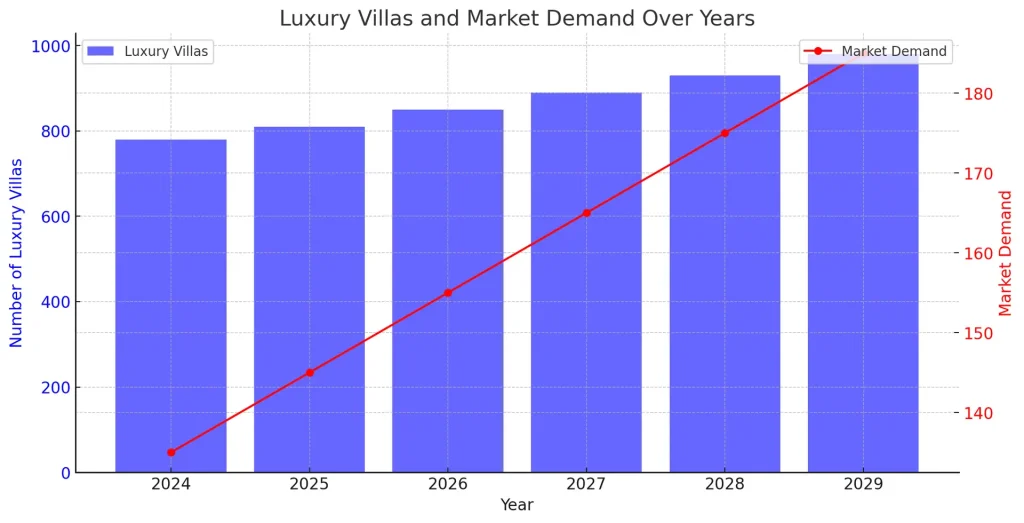
The chart shows the relationship between the number of luxury villas and market demand from the year 2024 to 2029. The blue bars represent the total number of luxury villas while the red line indicates the increasing market demand over the years.
3. Implications for investors and developers
The burgeoning market for luxury villas in Istanbul presents numerous implications for both investors and developers. As the city navigates its neoliberal restructuring, opportunities arise from the increasing commodification of urban space, particularly in affluent enclaves. Investors must critically evaluate market dynamics to optimize their asset portfolios in this competitive environment, acknowledging that the demand for branded housing projects is on the rise (Serin et al.). For developers, strategic positioning within these luxury sectors can lead to significant profit margins, provided they comply with ecological and sustainable building practices that enhance legitimacy and consumer appeal (Mizrak Bilen et al.). Ultimately, successful engagement in this lucrative market hinges on understanding socio-economic trends and aligning development strategies with emerging consumer preferences. By fostering a responsive approach, stakeholders can leverage Istanbuls unique position as a luxury destination, thereby maximizing their investments in this rapidly evolving landscape.
4. Recommendations for market participants
As the landscape of luxury villas in Istanbul continues to evolve, market participants must adopt strategic recommendations for sustained success. Engaging in comprehensive market research is critical to understanding consumer preferences and trends, directing developers toward properties that resonate with affluent buyers. In addition, fostering collaboration among real estate professionals, urban planners, and local authorities will enhance integration within existing neighborhoods, elevating overall livability. Moreover, embracing sustainable construction practices can attract environmentally conscious clients and create long-term value. As competition intensifies, leveraging technology, such as virtual tours and enhanced marketing strategies, will position participants favorably within this dynamic market landscape (Al Shawish et al.)(Alhubashi et al.). Ultimately, these proactive measures will not only address current demands but also anticipate future opportunities, reinforcing Istanbuls status as a premier destination for luxury living.
5. Final thoughts on the luxury villa market in Istanbul
In conclusion, the luxury villa market in Istanbul showcases a dynamic landscape shaped by both international demand and local preferences. The convergence of cultural heritage and modern amenities in these properties enhances their appeal, attracting affluent buyers from various backgrounds. Strategic investments in infrastructure and tourism further bolster this sector, making luxury villas not just residences but also lucrative assets. However, challenges such as regulatory complexities and fluctuating economic conditions require careful navigation. Ultimately, the sustained growth of this market signals a promising future, underscoring Istanbuls position as a premier destination for luxury real estate. As consumer behaviors evolve, adaptability will remain essential for stakeholders seeking to thrive in this competitive arena.
